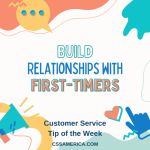
Here it comes again. It’s the issue that came to your attention last week but still hasn’t been fixed. It’s a glitch on the website, it’s a backorder issue, or it’s a new phone system causing the average wait time to double. You know about the issue, but – worse yet – your customers know about the issue. So how do you handle it when the customer brings it to your attention?
First, empathize and admit knowledge. Convey your understanding of the other person’s frustrations as you would with any complaint. Do not try to hide the issue. Tell them that you’re aware of it.
Second, note what is being done to resolve the problem. Tell them in general what is being done to address the issue. Even if it is a statement such as “We have a team looking at it” or “Our tech folks are investigating” or “The system is in the process of being upgraded” – those brief statements suggest that resolution is underway, and complaints of customers like the one that you’re talking with are being taken seriously. Don’t dwell on the details of the issue or all the specific actions being taken to rectify the concerns. This can get the conversation off track or going down negative path.
Transition to a near-term solution. Quickly move toward some alternatives that the customer could consider in the meantime. These are typically actions that YOU can take as opposed to having the customer go through several steps on their own to fix a problem that was caused by the company. For example, you could transition with statements such as: “Fortunately, we do have a couple other options for you to consider” or “However, there is some good news…” or “While we’re updating the website, here is what I can do for you right now…”
When dealing with a known issue, don’t ignore it, try to hide, or argue with the customer about it. Instead, empathize, admit knowledge, note the action being taken so they won’t have to deal with this again in the future, and quickly transition to an alternative.
Fix today’s customer issue even before the real issue is resolved for tomorrow’s customer.
Signup for FREE Tips! Contact Us More Resources for You Visit Our Home Page























